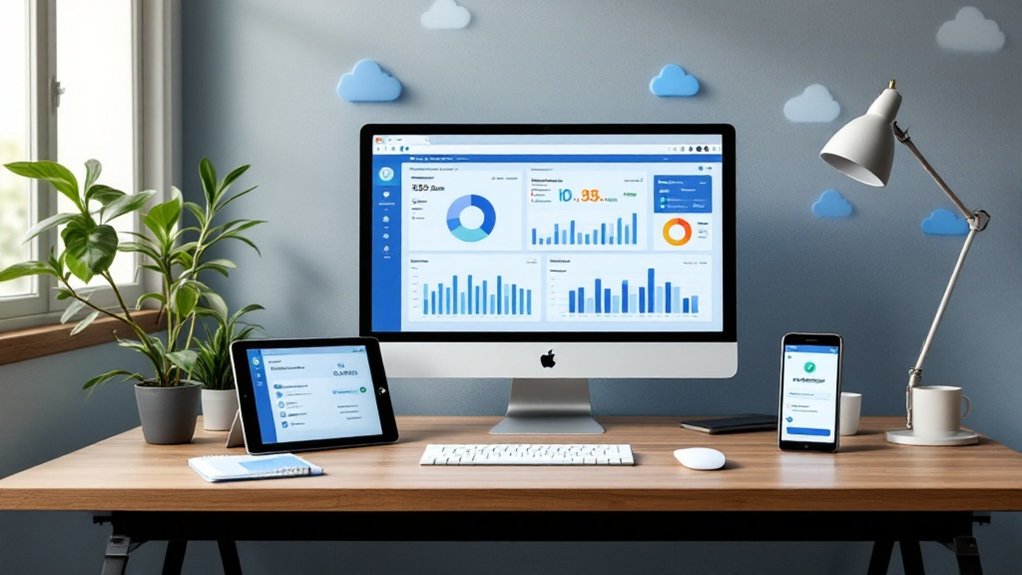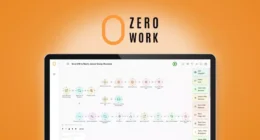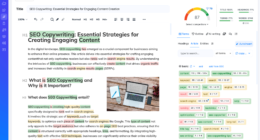Several reliable payroll software solutions cater specifically to small businesses, with popular options including ADP Run, Gusto, QuickBooks Payroll, OnPay, and Square Payroll. These platforms automate essential tasks like wage calculations, tax deductions, and direct deposits while ensuring compliance with tax laws. Most solutions offer cloud-based access, employee self-service portals, and integration with existing systems. Basic plans typically range from $20-50 monthly, making them accessible for growing companies ready to streamline their payroll processes.
Quick Overview
- QuickBooks Payroll integrates with accounting software and offers automated tax calculations, making it ideal for small businesses managing finances.
- Gusto provides a user-friendly platform combining payroll processing, benefits administration, and employee self-service features in one solution.
- ADP Run delivers comprehensive payroll management with multi-state tax capabilities and compliance support for growing small businesses.
- Square Payroll works seamlessly with Square POS systems, offering straightforward payroll processing for retail and service businesses.
- OnPay offers cost-effective payroll solutions specifically designed for restaurants and service industries with flexible payment options.
Understanding Payroll Software Features and Benefits

While managing payroll manually can be overwhelming for small businesses, modern payroll software offers an all-encompassing solution that streamlines the entire process.
These systems automate vital tasks like wage calculations, tax deductions, and direct deposits while maintaining high accuracy and security standards.
Key features of payroll software include automated payment processing, time and attendance tracking, and expense management capabilities.
The software also provides self-service portals where employees can access their payroll information, creating transparency and improving workplace satisfaction.
Perhaps most importantly, these systems guarantee compliance with tax laws and regulations through automated calculations and filings.
For growing businesses, payroll software easily scales to accommodate expansion while integrating seamlessly with existing HR systems and time-tracking tools, making it an invaluable investment for long-term success. Businesses can save significant resources since typical companies spend over 80 hours annually processing payroll manually. Popular platforms like Paychex and Homebase offer comprehensive solutions that combine payroll processing with scheduling and HR management functionalities.
Top Software Solutions for Small Business Payroll
Today's small business owners can choose from numerous payroll software solutions, each offering unique advantages for different business needs. Several standout options include:
- ADP Run: Extensive solution with automatic tax management and multi-state capabilities
- Gusto: User-friendly platform featuring automated payroll and benefits administration
- QuickBooks Payroll: Seamlessly integrates with QuickBooks accounting software
- OnPay: Cost-effective choice for restaurants and service industries
- Square Payroll: Ideal for businesses using Square POS systems
These solutions provide essential features like time tracking, tax compliance, and employee self-service portals. ADP Run stands out with its AI-powered error detection capabilities, ensuring accuracy in payroll processing.
Modern payroll platforms deliver core functionality that streamlines workforce management, from time tracking to regulatory compliance and employee access.
Cloud-based accessibility allows owners to manage payroll remotely, while mobile apps enable on-the-go processing. Most platforms offer detailed reporting tools and regular compliance updates, helping businesses stay current with regulations. Canadian businesses may also consider Wave Payroll for its simplified approach and affordable pricing structure.
Cost Analysis and Pricing Structures

Most small business owners face a complex array of pricing structures when selecting payroll software solutions. The market offers various models, from subscription-based services to fixed monthly fees, each designed to accommodate different business needs and budgets. Understanding these pricing structures is vital for making cost-effective decisions.
Key pricing considerations include:
- Base fees plus per-employee charges, common in platforms like Gusto
- Fixed monthly subscriptions that don't vary with employee count
- Freemium models offering basic services with paid upgrades
- Tiered pricing plans based on feature requirements
- Additional costs for services like tax filing and direct deposits
When analyzing costs, businesses should consider not just the monthly fees but also potential hidden costs such as setup fees, compliance charges, and data migration expenses. Small businesses can expect to pay between $20-50 per month for basic payroll software solutions.
Cloud-based solutions often provide more economical options for small businesses while maintaining essential features. Some providers offer free accounting tools that can be integrated with payroll systems to create a comprehensive financial management solution.
Security Measures and Compliance Standards
As cyber threats continue to evolve, robust security measures and compliance standards have become non-negotiable elements of small business payroll software. Key security features include data encryption, multi-factor authentication, and role-based access controls that protect sensitive employee information. Regular updates and audits guarantee compliance with regulations like FLSA and GLBA. A comprehensive incident management strategy helps businesses rapidly detect and respond to potential security breaches while minimizing data exposure risks.
| Security Feature | Purpose | Implementation |
|---|---|---|
| Data Encryption | Protect data during transmission | SSL/TLS protocols |
| Access Controls | Limit unauthorized access | Role-based permissions |
| Audit Trails | Track data modifications | Automated logging |
| MFA | Enhanced authentication | Multiple verification steps |
| Regular Updates | Guard against vulnerabilities | Automatic patches |
With data breach costs averaging $4.35 million in 2022, small businesses must prioritize security features when selecting payroll software. Employee education and vendor support further strengthen these protective measures.
Streamlining Operations Through Integration

Building upon robust security foundations, small businesses can further enhance their payroll processes through strategic software integration. Modern payroll systems connect seamlessly with other business applications, creating a unified workflow that saves time and reduces errors. Facial recognition options enable secure and accurate employee time tracking across multiple devices.
These integrations transform fragmented processes into streamlined operations, enabling businesses to manage payroll more efficiently. Advanced systems ensure 401(k) management automation while maintaining accurate recordkeeping for retirement benefits.
- Cloud-based solutions provide secure access to payroll data from any location
- Automated calculations guarantee accurate tax deductions and compliance management
- Employee self-service portals reduce administrative workload
- Real-time data synchronization keeps financial records current across all systems
- Integration with time-tracking software guarantees precise payment calculations
This interconnected approach not only minimizes manual data entry but also provides valuable insights for better decision-making.
Companies can scale their operations more effectively while maintaining accuracy and compliance.
Frequently Asked Questions
How Long Does It Take to Migrate Data From Legacy Payroll Systems?
Data migration from legacy payroll systems typically takes between 3 days to 8 weeks, depending on several factors.
The timeline varies based on data volume, system complexity, and required testing phases. Small organizations with straightforward data might complete migration within a week, while larger companies with complex historical records and multiple integrations often need 4-8 weeks.
Proper planning, data cleansing, and testing phases account for most of the timeline.
Can Employees Access Payroll Information During System Maintenance or Downtime?
Like a temporary road closure, system maintenance can restrict employee access to payroll information. During scheduled downtime, employees typically cannot access their digital payroll records.
However, most companies implement alternatives:
- Emergency paper-based records
- Pre-downloaded pay stubs
- HR hotlines for urgent requests
- Backup systems for critical data
Companies usually provide advance notice of maintenance windows and guarantee critical payroll functions remain accessible through alternate means, minimizing disruption to employees.
What Happens to Payroll Processing if Internet Connectivity Is Lost?
When internet connectivity is lost, desktop-based payroll systems can typically continue basic processing functions since data is stored locally.
However, certain operations like direct deposit submission and electronic tax filings will be paused until connectivity resumes.
Modern payroll software often includes offline capabilities and data caching to prevent work disruption.
While processing can continue, companies should maintain regular backups and have contingency plans for extended outages.
Are There Penalties for Switching Payroll Software Providers Mid-Year?
Switching payroll providers mid-year typically doesn't incur direct legal penalties, but there may be associated costs to evaluate.
Early termination fees from the current provider are common. Additionally, businesses should watch for indirect penalties like implementation fees, data transfer costs, or temporary dual-system expenses.
The key is carefully reviewing existing contracts and planning the change to minimize disruptions. Most providers are experienced in managing mid-year switches and can help navigate potential challenges.
How Do Payroll Software Solutions Handle Tip Reporting for Restaurant Employees?
While managing tip reporting may seem challenging, modern payroll software solutions make it straightforward.
These systems automatically track individual tip declarations, calculate required minimum tip allocations (8% of gross receipts), and generate necessary IRS reports. They also handle tip pooling arrangements and credit card tip distribution.
Most solutions offer real-time monitoring features, ensuring compliance with reporting requirements while providing detailed documentation for both employees and employers.
Conclusion
Like a well-oiled machine, small business payroll software streamlines operations while ensuring compliance and accuracy. By carefully evaluating features, costs, and security measures, business owners can select solutions that match their specific needs. Whether choosing cloud-based or desktop applications, the right payroll software saves time, reduces errors, and allows entrepreneurs to focus on growing their business rather than getting lost in administrative tasks.









